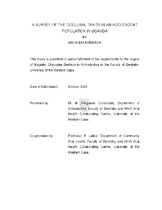| dc.description.abstract | Epidemiological studies on malocclusion have been primarily concerned with its aetiology and distribution. However, due to the varied and often subjective methods of assessment, many of these studies provide conflicting data related to malocclusions (Solow, 1970). To address this, the Fédération Dentaire Internationale (FDI) in close collaboration with the World Health Organisation (WHO) developed an objective method for measuring occlusal traits (Baume et al., 1973). This method was used to obtain the epidemiological data on occlusal traits for 14-year-old children Kampala in order to provide baseline data related to malocclusion. A total of 402 subjects were examined. Of these 65% were female and 35% were male. Thirty percent of the sample had at least one dental anomaly. The most commonly extracted teeth were mandibular first molars (43.6%) and maxillary canines (17.3%). The high frequency of extracted permanent canines in this sample is unique. By and large, many of the occlusal traits related to the canine are attributable to the practice of ebinyo, a form of dental mutilation, which still seem to be rife in many communities in Uganda. Similar to other studies (Massler and Frankel, 1951; de Muňiz, 1986; Ferguson, 1988; Kaka, 1993), mandibular first molars were five times more likely to be missing than maxillary first molars while the ratio of missing maxillary to mandibular canines was found to be 2.5:1. Crowding was most frequently observed in the mandibular incisal segment while spacing was mostly in the maxillary incisal region, thus supporting the view of Brunelle et al., (1996) that although prevalence may vary from study to study, more people have malaligned mandibular incisors than maxillary incisors concurs with these studies. Of the subjects studied, 6.8% had a diastema of 3mm and more. Regarding space measurements, 17.9% of the sample population had at least one segment with crowding, 18.2% had at least one segment with spacing while 33.6% had some degree of incisor malalignment and 54.2% of the sample population had some form of space anomaly. About 70% of the subjects had symmetric molar relationships of which 54.2% were Class I, 9.2% Class II and 3.2% Class III similar to the universal distributional pattern. Crossbites were not a major finding, and were present in only 7% of the sample. The distribution of overjet was relatively symmetrical on the left and right. Negative overjet (anterior open bite) was a rare occurrence in an average of 2.4% of the population. In 77.6% of the population, the overjet ranged from 1 to 4mm, and in 22.4%, the overjet was either edge-to-edge, reverse or 5mm and over. About 7.3% had an overjet of 5-6mm while only 2.1% had an overjet greater than 6mm. Approximately 53.7% of the population had an overbite of 1-3mm. Edge-to-edge and open bite incisor relationships were found in less than 10% of the sample. Although ideal occlusion as described by Angle (1907) in the Ugandan sample is very rare, using the data derived from this study, normal occlusion as defined by statistical distribution can be described. | en_US |

